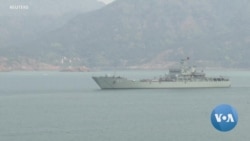ລັດຖະມົນຕີການຕ່າງປະເທດສະຫະລັດ ທ່ານ ແອນໂທນີ ບລິງເກັນ ແລະລັດຖະມົນຕີປ້ອງກັນປະເທດ ລອຍດ໌ ອອສຕິນ ໄດ້ພົບປະກັບຜູ້ນຳ ຟີລິບປິນ ທີ່ກະຊວງການຕ່າງປະເທດ ໃນຂະນະທີ່ສອງປະເທດ ໄດ້ເລີ່ມການຊ້ອມລົບຮ່ວມກັນຄັ້ງໃຫຍ່ສຸດ ໃນວັນອັງຄານນີ້ ທ່າມກາງຄວາມເຄັ່ງຕຶງທີ່ເພີ່ມຂຶ້ນກັບຈີນ ກ່ຽວກັບ ໄຕ້ຫວັນ ແລະການຮຸກຮານຂອງປັກກິ່ງ ໃນທະເລຈີນໃຕ້. ນັກຂ່າວຂອງວີໂອເອ ປະຈຳທຳນຽບຫ້າແຈ, ຄາຣ໌ລ່າ ບັບ (Carla Babb) ມີລາຍລະອຽດກ່ຽວກັບເລື່ອງນີ້, ເຊິ່ງ ອາດນາສັກ ຈະນຳເອົາມາສະເໜີທ່ານ ໃນອັນຕໍ່ໄປ.
ທະຫານສະຫະລັດ ແລະ ຟິລິບປິນໄດ້ດຳເນີນການຊ້ອມລົບທາງທະຫານ ບາລິກາຕານ (Balikatan) ໃນຟີລິບປິນ ໃນຂະນະທີ່ຜູ້ນໍາຂອງທັງສອງປະເທດ ໄດ້ພົບປະກັນຢູ່ທີ່ວໍຊິງຕັນ ເຊິ່ງຖືເປັນການພົບປະກັນຄັ້ງທໍາອິດໃນຮອບ 7 ປີ.
ລັດຖະມົນຕີການຕ່າງປະເທດຟີລິບປິນ ທ່ານ ເອນຣິເກ ມານາໂລ (Enrique Manalo) ໄດ້ກ່າວວ່າ “ໃນກອງປະຊຸມມື້ນີ້, ພວກເຮົາໄດ້ເພີ່ມທະວີຄວາມຮັບ ຜິດຊອບຂອງພວກເຮົາ ຂື້ນເປັນສອງເທົ່າ ເພື່ອປັບປຸງໃຫ້ພັນທະມິດຟີລິບປິນ-ອາເມຣິກາ ກ້າວໜ້າຂື້ນ, ການຮັບຮູ້ວ່າການຮ່ວມມືຂອງພວກເຮົາຈະຕ້ອງຮັບບົດບາດທີ່ໜັກແໜ້ນຍິ່ງຂື້ນໃນການຮັກສາຄວາມເປັນລະບຽບຮຽບຮ້ອຍຂອງກົດລະບຽບສາກົນໂດຍອີງໃສ່ກົດຫມາຍລະຫວ່າງປະເທດ.”
ໃນຂະນະທີ່ ລັດຖະມົນຕີປ້ອງກັນປະເທດສະຫະລັດ ທ່ານ ລອຍດ໌ ອອສຕິນ ໄດ້ກ່າວວ່າ "ຂ້າພະເຈົ້າຕື່ນເຕັ້ນກັບຄວາມສາມາດໃນການເພີ່ມທະວີການດຳ ເນີນງານຮ່ວມກັນ, ແລະຂ້າພະເຈົ້າຫວັງວ່າຈະໄດ້ສືບຕໍ່ເຮັດວຽກທີ່ຍິ່ງໃຫຍ່ຂອງພວກເຮົາຮ່ວມກັນຕໍ່ໄປ."
ຖ້ອຍຄຳເຫຼົ່ານີ້ແມ່ນຫ່າງໄກຈາກສະຖານະການຄວາມສຳພັນລະຫວ່າງສະຫະ ລັດ ແລະ ຟີລິບປິນ ເມື່ອສາມປີກ່ອນຫຼາຍ, ເຊິ່ງປະທານາທິບໍດີໃນເວລານັ້ນ ທ່ານ ໂຣດຣີໂກ ດູເຕີເຕ (Rodrigo Duterte) ໄດ້ຄັດຄ້ານຕໍ່ພັນທະມິດທາງທະຫານ ຢ່າງເປີດເຜີຍ.
ທ່ານ ເກຣັກ ໂພລິງ (Greg Poling), ຜູ້ອໍານວຍການໂຄງການ CSIS ເອເຊຍຕາເວັນອອກສຽງໃຕ້ (CSIS Southeast Asia Program Director) ໄດ້ກ່າວວ່າ "ພັນທະມິດສະຫະລັດ - ຟີລິບປິນ ໃນຕອນນີ້ ກຳລັງມີ ຊ່ວງເວ ລານື່ງໃນຊີວິດ ເຊິ່ງອາດຈະເປັນຄັ້ງທຳອິດໃນສອງສາມທົດສະວັດ, ທີ່ທັງສອງຝ່າຍເຂົ້າໃຈວ່າ ພວກເຂົາມີຄວາມຕ້ອງການກັນແລະກັນ ຢ່າງແທ້ຈິງ."
ຟິລິບປິນເປັນນຶ່ງໃນພັນທະມິດທາງທະຫານຂອງສະຫະລັດທີ່ມີການພັດທະນານ້ອຍທີ່ສຸດໃນພາກພື້ນນີ້ ແລະ ກຳລັງປະເຊີນໜ້າກັບໄພຂົ່ມຂູ່ຢ່າງຮ້າຍແຮງຈາກນື່ງໃນກອງທັບທີ່ມີອຳນາດຫຼາຍທີ່ສຸດໃນໂລກ ນັ້ນຄືຈີນ.
ທ່ານ ເກຣັກ ໂພລິງ (Greg Poling) ຍັງໄດ້ກ່າວຕື່ມວ່າ "ເປັນເວລາຫຼາຍກວ່າທົດສະວັດ ທີ່ປະທານາທິບໍດີຟີລິບປິນ ສາມທ່ານແລ້ວ ໃນປັດຈຸບັນນີ້, ທີ່ປັກກິ່ງໄດ້ປະຕິເສດ ທີ່ຈະໃຫ້ຟີລິບປິນ ມີພື້ນທີ່ໄດ້ຫາຍໃຈຢູ່ໃນທະເລຈີນໃຕ້."
ໃນປີ 2012, ຈີນໄດ້ຂັບໄລ່ຟີລິບປິນ ອອກຈາກເກາະດິນຊາຍ ສກາໂບໂຣ(Scarborough Shoal) ເຊິ່ງເປັນເຂດເສດຖະກິດຈຳເພາະຂອງຟີລິບປິນຢູ່ ທະເລຈີນໃຕ້ ແລະໄດ້ອ້າງວ່າ ເປັນດິນແດນຂອງຈີນ.
ທັງສອງຝ່າຍຕ່າງກໍມີໝູ່ເກາະທີ່ມີທະຫານປະຈຳການໃນທະເລຈີນໃຕ້ ແລະມີການຂັດແຍ້ງກັນຢ່າງຕໍ່ເນື່ອງ.
ນັ້ນແມ່ນໜ່ວຍຍາມຝັ່ງຂອງຈີນ ທີ່ບອກເຮືອບິນຈາກໜ່ວຍຍາມຝັ່ງຟີລິບປິນ ໃນເດືອນແລ້ວນີ້ ໃຫ້ອອກຈາກອັນທີ່ພວກເຂົາເອີ້ນວ່າ ດິນແດນຂອງຈີນ ເໜືອໝູ່ເກາະສແປຣັດລີ (Spratly) ທີ່ມີການຂັດແຍ້ງກັນ.
ປັດຈຸບັນນີ້, ສະຫະລັດ ແລະ ຟີລິບປິນ ໄດ້ຕົກລົງໃຫ້ສະຫະລັດນຳໃຊ້ຖານທັບໃໝ່ 4 ແຫ່ງ ໃນຟີລິບປິນ, ເຊິ່ງເປັນຈຸດທີ່ສຳຄັນໃກ້ກັບທະເລຈີນໃຕ້ ທີ່ມີການຂັດແຍ້ງກັນ ແລະ ໄຕ້ຫວັນ, ເຊິ່ງເປັນຈຸດພິເສດທາງດ້ານພູມສາດການເມືອງອີກແຫ່ງໜຶ່ງ ທີ່ຂະຫຍາຍໃຫຍ່ຂື້ນໃນພາກພື້ນ.
ລັດຖະມົນຕີການຕ່າງປະເທດສະຫະລັດ ທ່ານ ແອນໂທນີ ບລິງເກັນ (Antony Blinken) ກ່າວວ່າ “ເປົ້າໝາຍຂອງພວກເຮົາແມ່ນສັນຕິພາບ, ຄວາມໝັ້ນຄົງ, ສະຖຽນລະພາບ, ການສ້າງກາລະໂອກາດ. ມັນບໍ່ແມ່ນການເຂົ້າຮ່ວມ ໃນສົງ ຄາມເຢັນຄັ້ງໃຫມ່. ເຊິ່ງມັນບໍ່ແມ່ນການປິດລ້ອມຈີນ."
ຈີນໄດ້ສຳເລັດການຊ້ອມລົບທາງທະຫານອ້ອມຮອບໄຕ້ຫວັນ ເປັນເວລາສາມວັນ ໃນວັນຈັນນີ້, ເຊິ່ງລວມທັງການຊ້ອມລົບທີ່ຈຳລອງການໂຈມຕີທີ່ມີຄວາມຊັດເຈນໃສ່ເກາະດັ່ງກ່າວ. ພັກຄອມມູນິສຈີນໃຫ້ຄຳໝັ້ນສັນຍາວ່າ ຈະເຂົ້າຄວບຄຸມເກາະປະຊາທິປະໄຕ ພາຍໃນປີ 2027, ໂດຍຈະໃຊ້ກຳລັງຖ້າຈຳເປັນ.
U.S. Secretary of State Antony Blinken and Secretary of Defense Lloyd Austin met with Philippine leaders at the State Department as the two countries began their largest joint military drills Tuesday, amid increased tensions with China over Taiwan and Beijing’s aggression in the South China Sea. VOA Pentagon correspondent Carla Babb has details.
U.S. and Filipino soldiers launched Balikatan military drills in the Philippines as leaders from the two nations met in Washington for the first such talks in seven years.
Enrique Manalo, Philippine Secretary of Foreign Affairs
“At today's meeting, we redoubled our commitment to modernizing the Philippine-U.S. alliance, recognizing that our partnership will need to play a stronger role in preserving an international-law-based international order.”
Lloyd Austin, US Secretary of Defense
“I'm excited about the ability to increase interoperability, and I look forward to continuing our great work together.”
Those words are a far cry from the state of U.S.-Philippine relations just three years ago, when then-President Rodrigo Duterte openly disapproved of the military alliance.
Greg Poling, CSIS Southeast Asia Program Director
“The U.S.-Philippine alliance is really having a once-in-a-generation moment right now where both sides have realized maybe for the first time in a couple decades that they really need each other.”
The Philippines is among the least developed of America’s military allies in the region, and it faces an acute threat from one of the world’s most powerful militaries: China.
Greg Poling, CSIS Southeast Asia Program Director
“For more than a decade, three Philippine presidents now, Beijing has just refused to give the Philippines some breathing space in the South China Sea.”
In 2012, China pushed the Philippines out of Scarborough Shoal — a territory well within the Philippines exclusive economic zone in the South China Sea — and claimed it as Chinese territory.
Both sides have militarized islands in the South China Sea and are in constant conflict.
That’s the Chinese coast guard telling a Philippine coast guard plane last month to immediately leave what it called Chinese territory over the disputed Spratly Islands.
The U.S. and the Philippines have now agreed on U.S. access to four new bases in the Philippines, key locations near the contested South China Sea and Taiwan, another geopolitical flashpoint looming large in the region.
Antony Blinken, US Secretary of State
“Our goal is peace, security, stability, creating opportunity. It's not to engage in a new Cold War. It's not to contain China.”
China completed three days of military exercises around Taiwan on Monday, which included a drill that simulated precision strikes on the island. The Chinese Communist Party has vowed to control the democratic island by 2027, using force if necessary.





